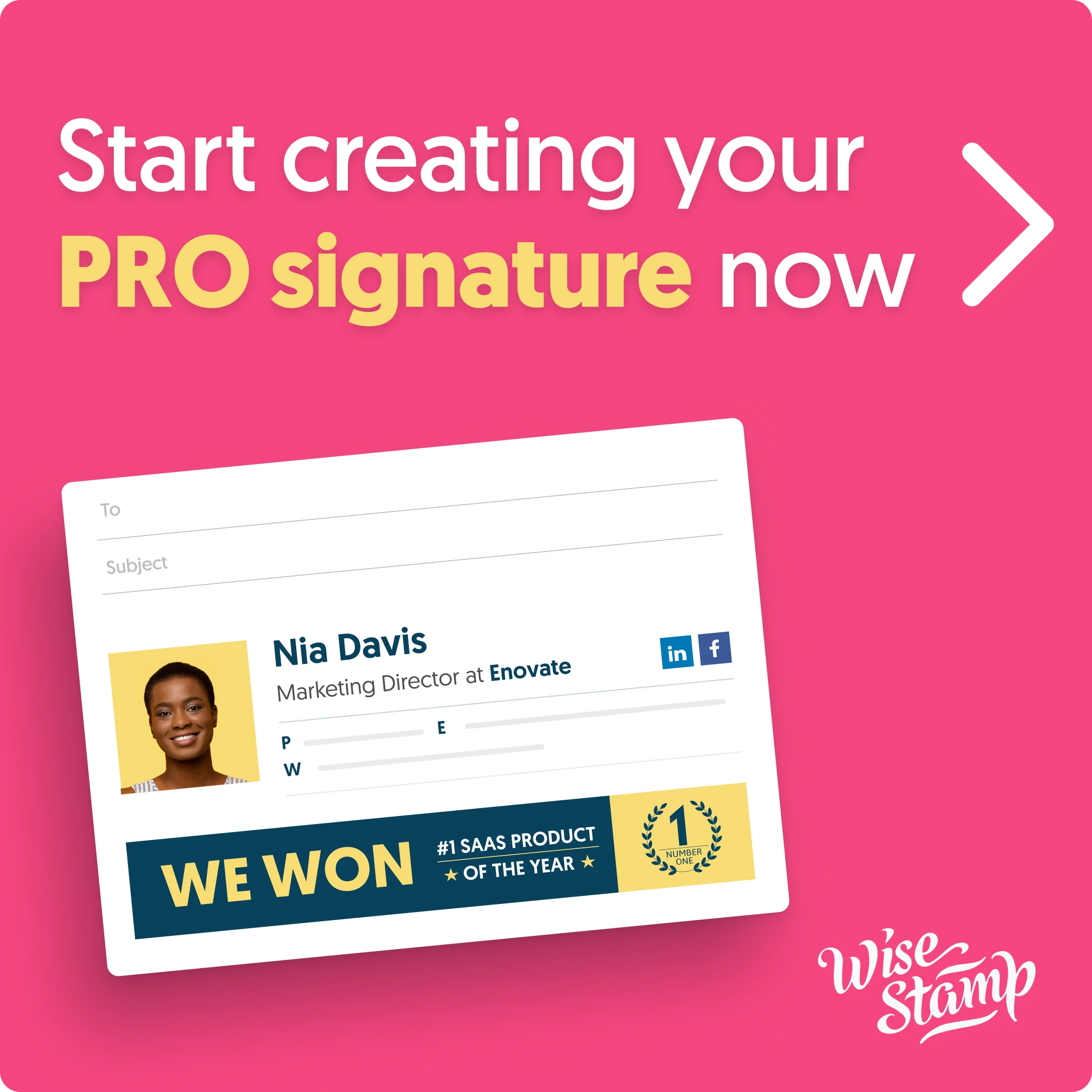Best signatures by famous businessmen (breakdown & tips)
Create a powerful and appealing personal signature based on hand signatures by successful businessmen, famous entrepreneurs, and rich people.
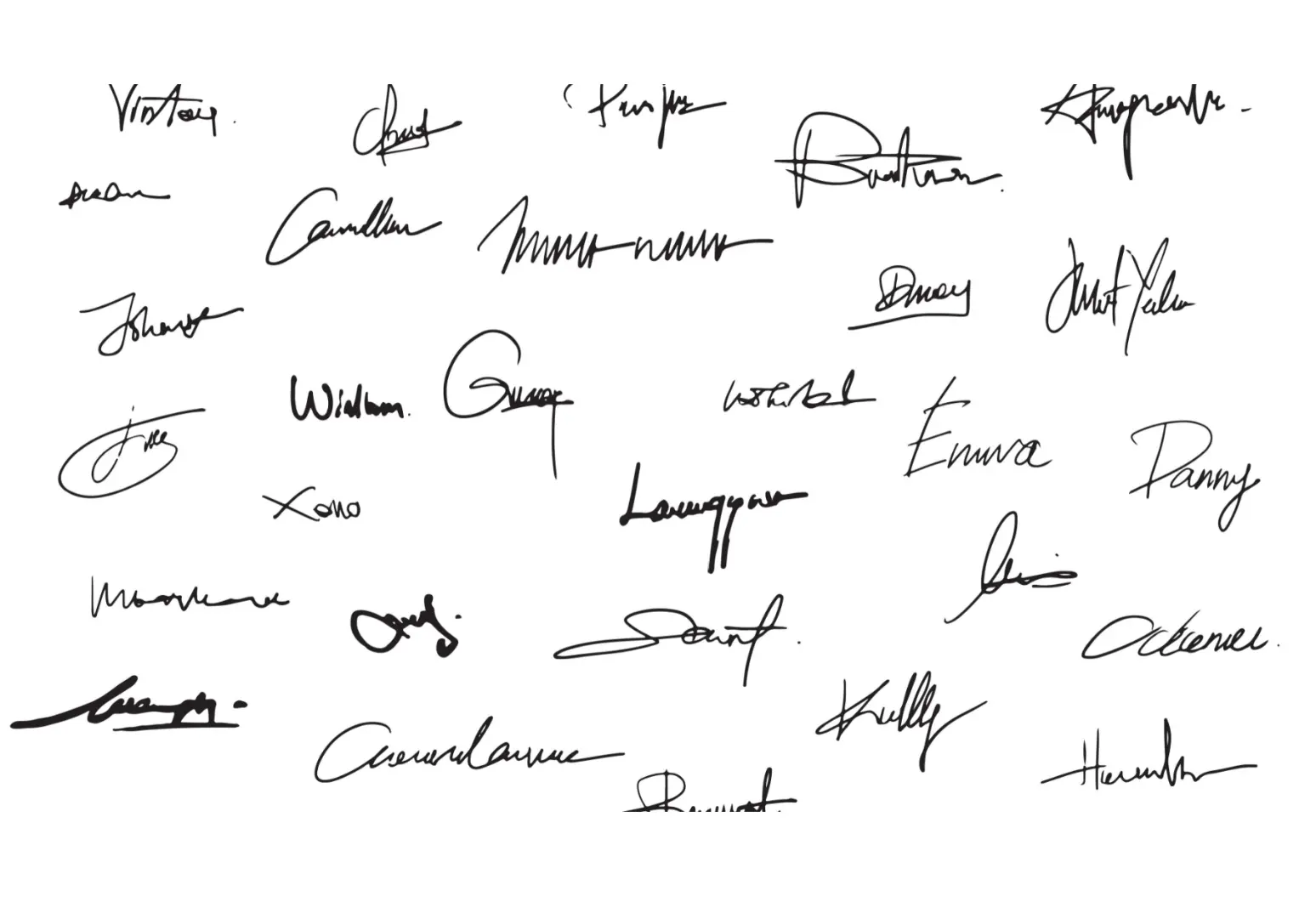
The best hand signatures convey authority, efficiency, and creativity. Many people will associate these properties with the person who made the signature. Anyone can develop a powerful signature based on hand signatures by successful businessmen, famous entrepreneurs, and rich people.
This article will show you how.
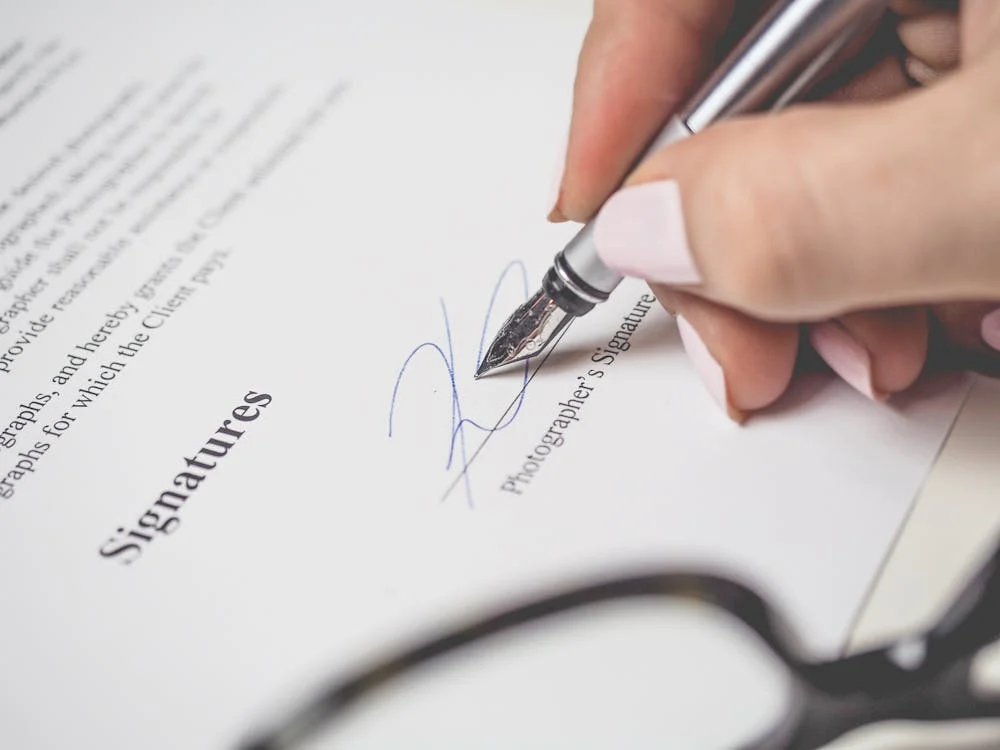
Signature vs autographs
Many people seem to get mixed up between autographs and signatures. An autograph is generally used by a celebrity or famous person in a public setting, such as on an image or in a book. Usually, a celebrity’s autograph is not the same. The reason is that if their signature was in the public sphere, it could become subject to fraud.
Unlike celebrities, the average person does not need more than one style of signature. When you choose how to sign your name and what your signature will look like, it should look the same regardless of the type of contract or document you’re signing.
Of course, there’s no legal requirement for keeping your signature identical. Technically, you can sign your rental contract, car lease, and employment contract with entirely different signatures. Each one would be legal. However, you risk running into issues down the line if your signature ever gets called into question and needs to be compared with signatures on other legal documents.
How to create a hand signature?
Signatures have been used to prove the identity of someone, and have been used to certify important documents. Who can forget John Hancock’s infamously theatrical signature on the Declaration of Independence?
But besides the style, everyone will have their own preferences for how to write their name.
Examples of the name variations you can use as your signature:
- First and last name: Albus Dumbledore
- Full name, including middle names: Albus Percival Wulfric Brian Dumbledore
- Initial of your first name and full last name: A. Dumbledore
- Initials of your first and middle names and full last name: A. P. W. B. Dumbledore
- Initials only: A.D.
There is some debate on whether initials should be a signature. It’s more acceptable to use any of the other variations. However, as it was mentioned earlier, as long as your signature is uniform across any document you sign. A signature consisting of just initials is completely fine.
The basic style properties of handwritten signatures
First, let’s look at what your signature says about your personality before looking at famous signatures. These will indicate how someone conducts themselves, along with showing how they want to be identified.
We’ll cover these properties and what they signify:
- Angle
- Size
- Legibility
- Completeness
- Embellishments
Take a moment to write down your signature so we can break it down
Before getting started, grab a black piece of paper and sign it with your original signature. Put the paper aside and come back later to analyze it. You can do it on paper or use our free signature generator.
1. Angle
There are three different angles that a signature will be: ascending, descending, and straight. Each one will inform others a little bit about your personality.
- Ascending – Ambition, optimism, and creativity
- Descending – Pessimistic
- Straight – Balance, organized, and self-sufficient

2. Size
The size of your signature will provide further insights into how you carry yourself. A CFO study by Dr. Charles Ham looked at hundreds of signatures of CFOs and came to the following conclusions.
- Large Signature – Confident, while also more likely to be narcissistic and bend the truth.
- Small Signature – Need to claim more space and not place yourself in a small box.
3. Legibility
The legibility of your signature will say a little something about how your mind works.
- Illegible Signature – Reflects a quick mind that doesn’t get bogged down by details.
- Legible Signature – Displays openness and straightforwardness.
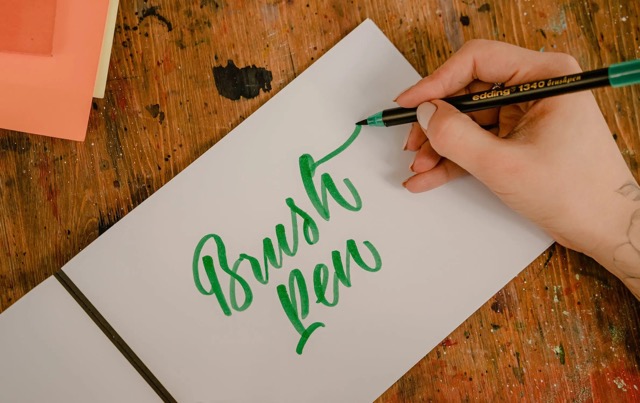
4. Completeness
Differences in completeness, when it comes to either signing your full name or using initials, will also make a difference.
- Initials or First Name – Independent, efficient, and private.
- Full Name – More open.
5. Embellishments
Embellishments are special touches added to your signature. These say something about your personality. The more embellishments, the more complicated the person, while a more simple signature suggests a more straightforward person.
- Long Lines – Determination, drive, and perseverance
- Hard Stop – Strong sense of self and seriousness
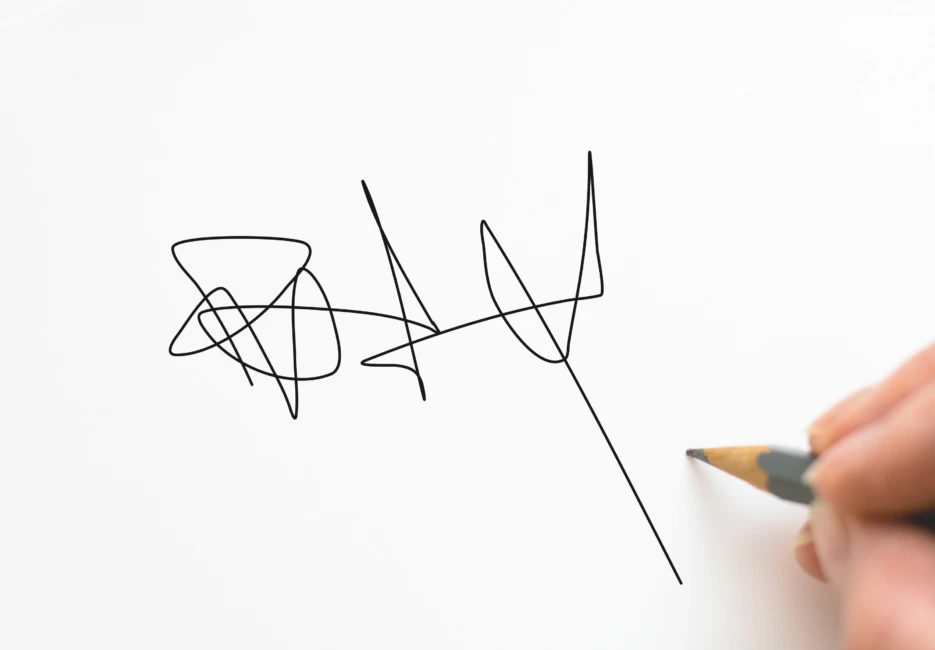
How to choose the best signature
There are many different types of signatures out there, but ultimately, the one you choose should reflect your own identity. A hand signature is by nature something personal and is used for this reason to indicate your personal authentication. While it can evolve slightly over a person’s lifetime, it generally stays the same. This allows a significant degree of confidence when authenticating your documents over time.
Top 15 famous handwritten signatures you can take inspiration from
It can certainly be a good idea to take inspiration from famous CEOs and founders of large businesses when recreating your hand signature. Signatures of famous personalities can manifest their social standing over time. You may be able to mimic those and their properties, so some of what it says about them will be attributed to you. So, let’s explore some famous signatures so you can become familiar with the little details.
Here are the top 15 famous handwritten signatures of entrepreneurs you are probably familiar with. You will see Some of the nuances we covered in the “basic properties of handwritten signatures” within these examples, so pay attention and think about how you can incorporate any of these in your own signature.
Steve Jobs

Co-founder of Apple, the late Steve Jobs went unconventional in his signature and wrote it in all lowercase script. He would write his name in an ascending angle, telling us that he had ambition and was forward-thinking.
Steve Wozniak
Another co-founder of Apple, Steve Wozniak, signs his name by using his nickname, Woz. What this shows is his independent-mindedness, as well as high self-confidence. By making the ‘W’ in his name quite large and slanted, it demonstrates his high self-esteem.
Meg Whitman
Meg Whitman was the CEO of Hewlett-Packard for a long time. She demonstrates her drive and determination in the long line going straight out after the last letter in her signature. The fact that she signs her first name very legibly, while scribbling her last name, indicates she is proud of her accomplishments.
David Packard
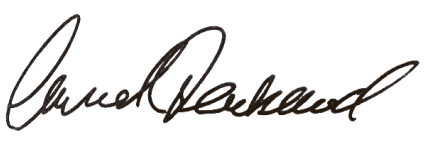
One of the co-founders of Hewlett-Packard, David Packard, used to sign his signature upwards, which shows that he was an ambitious and optimistic person. He pronounces and emphasizes the first letter of both his first and last name, which shows his confidence. He also doesn’t leave a space between his first and last name, showing off his rich character.
Satya Nadella

As the CEO of Microsoft, Satya Nadella doesn’t spell out his last name besides his first initial. This shows off his easygoing nature. However, the period after that initial tells people that he is also a strong business leader.
Jeff Bezos
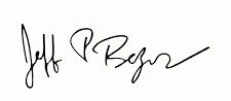
Jeff Bezos is the founder of the massive Amazon. He signs his first name legibly but makes it difficult to read his last name. This shows he is proud of his personal accomplishments. His last name ends with an ascending streak, showing us that he has an energetic character.
Michael Dell
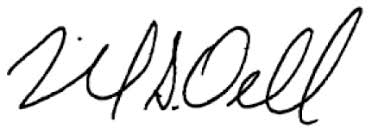
The founder and CEO of Dell, Michael Dell, signs his name perfectly straight. He stays meticulous by precisely lining up the dot for the ‘i’ in his first name where it needs to go. This shows he pays great attention to detail and stays precise in all he does.
Brian Krzanich

As the former CEO of Intel, Brian Krzanich is someone who would scribble his signature. This showcases his sharp intelligence. It also shows that he is a busy person who has little time for things like signing his name. The only letters in his signature that are legible are the first letters of his first and last name. They are also much more substantial than all the other letters. Both of these features display the immense confidence this businessman has.
Larry Page

Larry Page is one of the co-founders of Google, who interestingly keeps the first ‘a’ in his name open at the top. This tells people he likes to share his thoughts with others. Again, as with others, the significantly larger first letters of his first and last names indicate he has high self-worth. Keeping his name straight throughout demonstrates he has a balanced approach when it comes to working.
Sergey Brin
Being the other co-founder of Google, Sergey Brin is a “big picture” guy. He lets others deal with the specifics and details of things. Also, he signs his first name more legibly than his last, suggesting he can be easily approachable. It also shows he speaks in a straightforward and direct way.
Kevin Systrom
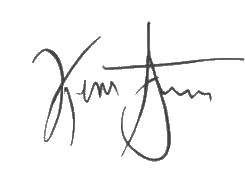
Kevin Systrom is the co-founder of Instagram, who signs his signature by making the first letters in both first and last names huge. In fact, they are slightly outrageous, indicating he may be a bit arrogant. Nixing the dot for the ‘i’ in his first name demonstrates he is also a ‘big picture’ guy.
Reid Hoffman
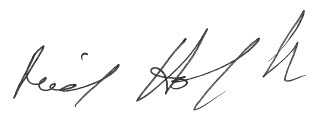
Reid Hoffman is the co-founder of LinkedIn, who signs his name in a very ascended manner. This shows how ambitious of a person he is. Also, it indicates that he plans for the future. The dot over the ‘i’ in his first name is almost an afterthought, demonstrating that he is always on the move.
Jack Dorsey

As the co-founder of Twitter, Jack Dorsey incorporates this into his signature. Instead of the traditional first and last name, he makes it @jack. This incorporates the method of identifying someone on Twitter, and shows he is open and straightforward with how he communicates. Also, by not adding his last name, he shows people that he is a relaxed and easygoing person.
Kevin J. Kennedy

Once the CEO of Avaya, Kevin J. Kennedy takes quite a journey with the line he draws stemming out of the ‘y’ in his last name. This suggests he sees himself as a very important person and wants to lead a commanding presence. Also, the fact that the line travels all the way to before his first name indicates he is someone who frequently looks to the past.
Mark Zuckerberg

As the CEO of Facebook, you would expect Mark Zuckerberg to be an open person. However, signing barely more than his initials tells us he is actually very private. Every letter is capitalized though, which indicates he has high confidence in himself, as well as high self-esteem.
How to use your hand signature to get ahead in life and in business
When comparing what the studies related to “signature science” have found to the famous people’s signatures we looked at, the science overall checks out.
Of course, these don’t take into account whether someone is ‘faking’ their signature to appear a certain way, or attempting to mask something like narcissism. However, it’s quite accurate overall. When you look at the signature of famous personalities, you can see that the studies done on signatures are relatively accurate.
Now it’s time to get to know how you can properly use your hand signature to get ahead in life and business
Types of signatures and their uses
The personal signature has gone through several transformations in its long history. Before arriving where we are today with electronic and digital versions. However, the signature’s meaning and purpose have largely remained. The same throughout the years: it’s a personal depiction of someone’s name that proves identity and is often affixed to documents to represent certification.
Digital signatures these days have become the norm for a lot of different scenarios, such as signing a contract. It’s become relatively commonplace to add your digital signature to documents, however, it wasn’t always such a simple affair.
Electronic signature vs digital signatures
It’s important to know that there’s a difference between an electronic signature and a digital signature.
An electronic signature or an e-signature is generally accepted as being an acknowledgment of an electronic message. According to the E-Sign Act of 2000, an electronic signature is defined as “an electronic sound, symbol, or process, attached to or logically associated with a contract or other record and executed or adopted by a person with the intent to sign the record.”
A few examples of an electronic signature are:
- A name typed in a document in electronic form
- Adding a typed name at the end of an email
- In banking, your PIN (Personal Identification Number) is considered an electronic signature
- A digitally captured image of your handwritten signature, such as on a touch-screen device
Digital signatures, on the other hand, involve a lot more security features compared to an electronic signature and are generally considered to be a lot more secure. A digital signature will include a certificate of authenticity that ensures the signature on a document is valid.
When using a digital signature, all parties can see when a document was changed in a way that would render it invalid. The sign-off includes a private decryption key, which makes it a lot more secure and verifiable by anyone involved.
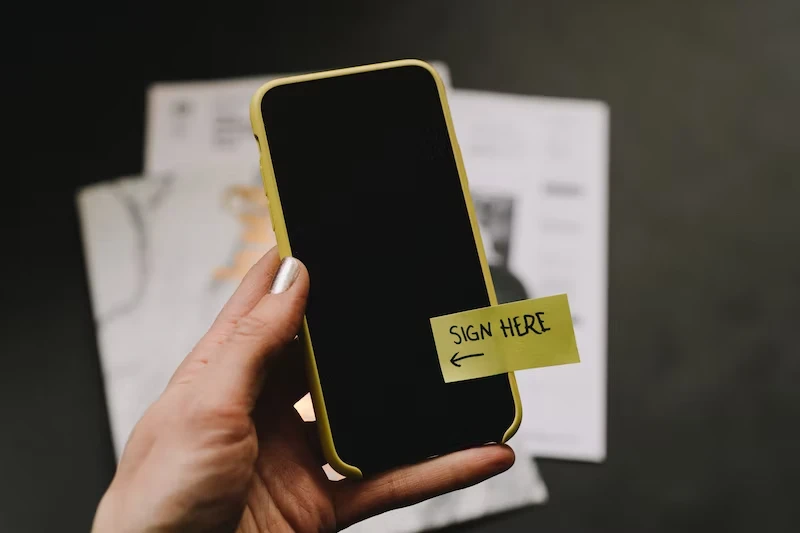
Wet Signatures
If someone asks you for a wet sign-off, don’t be too confused.
A wet signature is simply a handwritten signature that is done in person on an original copy of a contract or document. Today this type of signing can be encountered when opening a bank account or signing any legally binding documents.
The term “wet signature” evokes the idea of a done-in ink that takes time to dry. Of course, these days you won’t be signing any documents with a quill and parchment, so wet signatures mainly refer to a contract signed in person, not digitally or electronically.
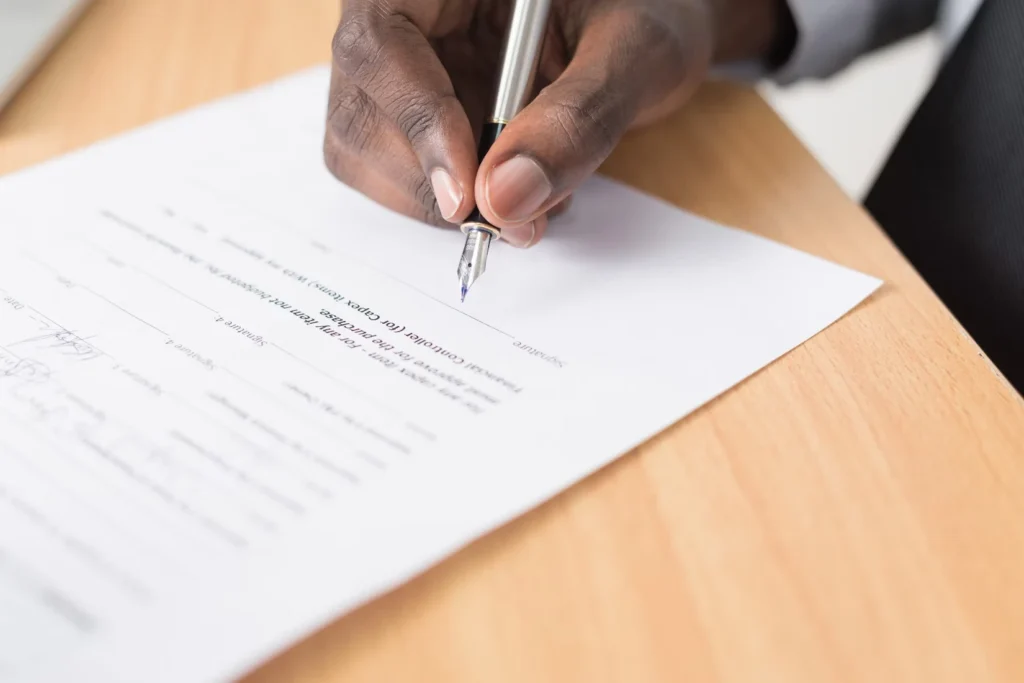
Email Signatures
These days, most business and personal correspondence is done using email. This has virtually wiped out the use of the classic signature. However, you can get a media-rich signature added to your emails that can provide a wealth of information for others. Simply typing your name will be something you will never want to go back to again, once you start using Wisestamp’s signature features.
When it comes to picking a signature for your email, there are plenty of options here too. Aside from including your name. You also need to choose an appropriate email sign off. Any relevant links, and other contact information.

Made with WiseStamp
Generals tips and guidelines when making your email signature:
- Keep it simple: you don’t always need an elaborate signature. Make sure to include your name, job title, company, and phone number, and you’ll be good to go. No need to add all your phone numbers, fax numbers, addresses, or multiple emails if it’s not relevant.
- Include an image: it’s become more popular to add a small profile image aligned with the text of your signature. This adds a personal touch and can help new clients or partners get to know you better through an email.
- Add your logo: if you don’t want to add an image of yourself, you can add your company’s logo.
- Use social icons: it’s a good idea to add icons or links to your business’s social platforms. Your clients can easily find you online and so you drive traffic to your different channels.
- Share other business information: Aside from adding social icons or links. You can also use your signature to share a link to your business’s latest blog post. Your company’s recent awards, or even a CTA for newsletter sign-ups.
- Make sure it’s mobile-friendly: since most people nowadays check their emails on their phone. It’s important to ensure that your signature looks good on multiple devices.
Try using the WiseStamp free email signature maker to create a custom email signature where you can design the look exactly how you want it. It also has tons of different social media icons to choose from. So, you can add all your different channels to your email signature, as well as links to your blog posts, promotional banners, and even legal disclaimers.
Whether you are a freelancer, entrepreneur, or small business, Wisestamp can provide you with a signature solution that is simply unmatched anywhere else. We enable you to add a rich and professional signature to every email you send.
These unique signatures can promote your business with every correspondence, strengthening your brand, getting more leads, and engaging people with your social media accounts. Help your business grow and enjoy a more dynamic signature by going with Wisestamp.
Signature history & evolution: a brief timeline
The meaning of a signature has stayed the same over the years, but it has taken on many forms. Today, we may primarily think of a signature as a way to close an email. When you look back throughout history. A signature has meant so many different things.
In order to understand and appreciate the signature as we know it, we should learn about its origins. Read on to discover the signature’s history throughout different eras until its modern adaptations today.
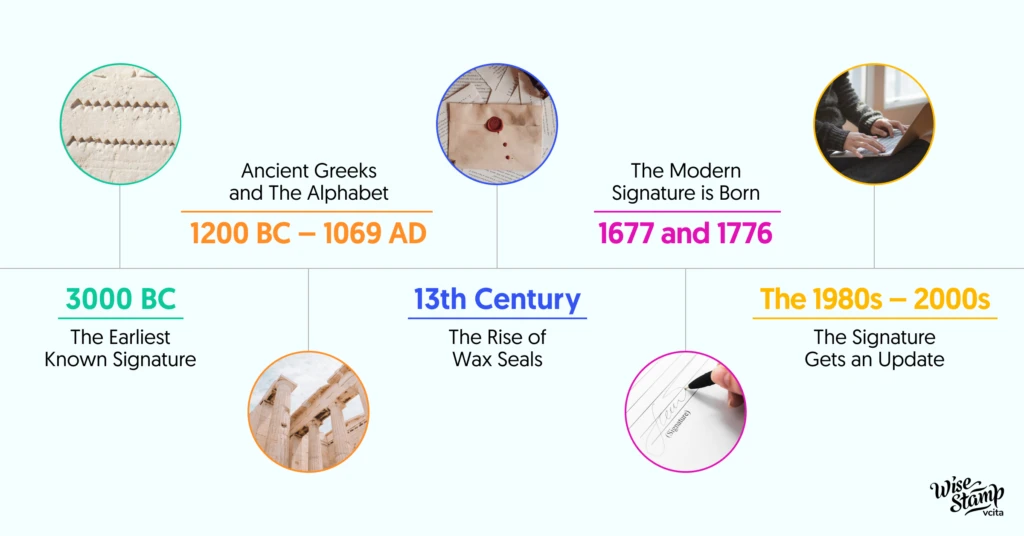
Different time periods saw different versions of a signature. Its medium has changed over time, taking on different forms and contexts.
The only constant is that man has been using a signature. In one form or another, for over a thousand years to denote a personal identification, confirmation, or witness.
Let’s take a brief look at the signature’s history and its evolution over time.
3000 BC: The Earliest Known Signature
Some of the first identifiable signatures date all the way back to 3000 BC. In ancient societies such as the Egyptians and Sumerians. These societies began etching pictographs, such as hieroglyphics, consisting of images that convey an event, story, or historical moment.
A Sumerian tablet dating back to 3100 BC is thought to be the earliest example of a signature. This clay tablet has markings of a scribe, Gar Ama, and is considered an ancient example. Someone uses a combination of words and symbols to indicate their identity.
1200 BC – 1069 AD: Ancient Greeks and The Alphabet
Many things happened with the way language was conveyed and written over this long period of time. The ancient Greeks and Romans placed a great deal of importance on language.
Around 1200 BC, the Greeks began using the Phoenician alphabet. Over the next few centuries. It evolved into the more modern Latin alphabet that we use today.

It wasn’t until 1069 that we got the first documented use of a signature using the Latin alphabet from a well-known historical figure. El Cid, a Medieval military leader from Spain, left a signature of his name in a document demonstrating a donation he made to the Cathedral of Valencia. El Cid’s signature would become closer to what we know today as the modern.
13th Century: The Rise of Wax Seals
Though not a classic signature involving a name scribbled on a document, wax seals served a similar purpose as signatures.
The wax seal became more popularized in the Middle Ages. It was typically used by nobility or clergy members, such as monarchs, royal representatives, and bishops. A wax seal often provided a level of authentication to a document, such as a contract or an official letter.
Like signatures, each seal was completely unique to its owner. Though the Latin alphabet was already invented, a lot of people remained illiterate. The wax seal gained more popularity and became more frequently used. Among common people, it was a good alternative for those who didn’t know how to read or write.
One of the most famous documents signed with a wax seal is the Magna Carta. In 1215, the King of England stamped the document with his seal. The Magna Carta went on to be one of England’s most important documents.
1677 and 1776: The Modern Signature is Born
In 1677, the English Parliament passed The Statute of Frauds Act, which allowed signatures to become what they are today.
The act was instated to curb the rise of fraud. The law stated that contracts need to be signed and that a signature implies a binding contract.
John Hancock’s famous signature on the American Declaration. Independence in 1776 would go on to become one of the most recognizable signatures in history. More importantly, his signature denotes a binding contract.
The 1980s – 2000s: The Signature Gets an Update
Like everything else that got updated with the rise of technology, the signature was no exception.
In the 1980s when fax machines became more commonly used in business and daily life, contracts were often scanned electronically. Therefore, laws had to be changed in many countries in order to adapt to this new technology. In order to ensure the legality and authenticity of these electronically sent documents.
Indeed, they saw a huge shift with more advanced technologies, such as digital and electronic signatures.

